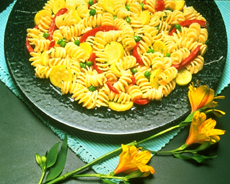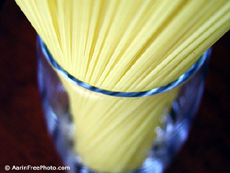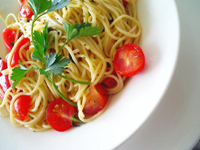

Pasta Primavera: a way to eat your vegetables and enjoy pasta too. Photo courtesy of the National Pasta Association, ilovepasta.org.
March 2005
|
 |
Pasta Cooking Tips
Everything You’ve Wanted To Know About...
Buying Pasta
How much pasta do you need per person?
- One pound dry macaroni-type pasta yields nine cups cooked; one pound of spaghetti or linguine yields seven cups cooked. As a main course, 1/4 cup of dried pasta (4 ounces) per person. A one-pound package should provide four dinner-size servings.
- If you’re serving pasta as a first course or a side dish, 1/8 cup of dried pasta (2 ounces) per person.
- The final cooked amount will vary by shape. Spaghetti and macaroni shapes can double in volume when cooked. If you read package boxes, e.g., you may note that 1/2 cup elbow macaroni = 1 cup cooked pasta, 3/4 cup penne = 1 cup cooked pasta, 1/8 lb. spaghetti = ¼ cup cooked pasta, etc. See the chart below for rules of thumb.
- Egg noodles do not expand significantly when cooked; and fresh pasta, which contains a lot of moisture, expands not at all. For these items, use three ounces for a first course or side dish and five ounces for a main dish.
- Read the package label and be sure to buy a semolina-based pasta. All American and Italian pastas are made from semolina, which is the ground kernel of durum wheat. It is the ideal wheat to achieve an al dente pasta that holds its shape while cooking. Pasta from other countries can be made with all-purpose flour, which is easy to overcook.
Here are some guidelines from the National Pasta Association:
| Type of Pasta |
Uncooked Weight |
= |
Cooked Amount |
Small to Medium Pasta Shapes
Bow Ties, Elbow Macaroni, Medium Shells, Mostaccioli, Penne, Radiatore, Rigatoni, Rotini, Spirals, Twists, Wagon Wheels |
8 oz. uncooked |
= |
4 cups cooked |
Long Pasta Shapes
Angel Hair, Fettuccine, Linguine, Spaghetti, Vermicelli |
8 oz. uncooked or
1½ inch diameter bunch |
= |
4 cups cooked |
| Egg Noodles |
8 oz. uncooked |
= |
2½ cups cooked |
Chart and storage tips courtesy of the National Pasta Association, www.ilovepasta.org.
Cooking Pasta
Follow these steps to perfect pasta:
- Each pound of pasta requires 4-6 quarts of water (or, a quart of water per ¼ pound), so be sure to start with a large enough pot. The large quantity of water ensures that the pasta has room to expand and doesn’t stick together. Some cooks believe a tablespoon of olive oil or other cooking oil helps to keep the pasta from sticking.
- Add a tablespoon of salt. Sea salt or Kosher salt helps bring out the flavor of the pasta better than regular table salt.
- When the water boils, add the pasta, stir gently and return water to a second boil. Keep it at a rolling boil, uncovered, for the duration of cooking. Stir occasionally to keep the pasta from sticking to the bottom of the pot.
- Follow the manufacturer’s package directions for cooking time. Stir the pasta occasionally during cooking to keep it from sticking and to enable it to cook evenly.
- Don’t break long pasta to fit the pot: it‘s un-Italian. The enjoyment of “long goods” is in the twirling. Use a wooden spoon to bend and lower it as it cooks until it fits.
- If the pasta is to be used as part of a dish that requires further cooking, undercook the pasta by 1/3 of the cooking time specified on the package.
- Several minutes before the end of the recommended cooking period, begin testing the pasta to determine if it is done. Perfectly cooked pasta should be “al dente,” or firm to the bite, It should be cooked through, without a large, white, uncooked center or ring. A small white dot of uncooked core means it’s al dente, finished. If not, let it cook another minute.
- Don’t overcook: the hot pasta will continue to cook a bit after it is taken off the flame.
- Drain the pasta in a colander and follow the rest of the recipe.
- Do not rinse. The only time you should rinse pasta after draining is when you are going to use it in a cold dish like pasta salad; further cook it in a casserole-style recipe like lasagna or stuffed shells; or when you are not going to sauce and serve it immediately. In these cases, rinse the pasta under cold water to stop the cooking process, and drain well. Otherwise, rinsing removes important surface starch that helps sauce cling to pasta.
- Don’t over-sauce pasta. Good pasta has good flavor: let it shine through.
Serving Pasta
You’re ready to eat—almost.
- Serve the pasta as soon as it is cooked. Pasta can get gummy as it cools.
- Warm the bowl or platter the pasta is to be served in the microwave (or use boiling water) before placing the pasta in it.
- Add a tablespoon of olive oil or butter to the drained pasta before placing the sauce over it.
- If you’re using Parmesan cheese and tossing the pasta, add some cheese before tossing; and bring grated cheese to the table to pass after the portions have been served. Parmesan should be freshly grated at the time it is served; however, for everyday use you can grate cheese and store it in the freezer.
- Serve pasta in large shallow bowls. Flat plates let the pasta cool and the sauce drip over the edge.
Eating Pasta
It’s easy to eat “short” pasta shapes, but long pasta is a challenge. Logically, we would cut it up into manageable pieces, but that’s un-Italian. There are two “official” Italian methods:
-
Separate 2 to 3 strands of pasta from the main body with your fork and twist it around the fork. It doesn’t all have to be wound, i.e., it’s OK if some is hanging. Sitting close to the table, hold your head over the plate and pop the pasta into your mouth, biting off any hanging strands (which will fall back onto your plate).
-
Perhaps the more elegant way is to use a round soup spoon and a fork. Separate a few strands of the pasta with your fork. Then twist it around in the bowl of your spoon to form a manageable mouthful, and raise the fork to your mouth.
Storing Pasta
Uncooked Pasta
 |
| Pasta photo courtesy of AarinFreePhoto.com. |
Store uncooked, dry pasta in your cupboard. Egg pastas can be stored for up to one year, non-egg pastas for two years. Keep pasta in a cool, dry place. Follow the “first-in, first-out” rule: Use up packages you’ve had the longest before opening new packages.
Cooked Pasta
Refrigerate cooked pasta in an airtight container for three to five days. You may add a little oil (1-2 teaspoons for each pound of cooked pasta) to help keep the pasta from sticking together. Pasta will continue to absorb flavors and oils from sauces, so unless that is your goal, store cooked pasta separately from sauce.
Freezing Pasta
The best pasta shapes for freezing are those that are used in baked recipes, such as lasagne, jumbo shells, ziti and manicotti. You’ll have better results if you prepare the recipe and freeze it before baking. To bake, thaw the dish to room temperature and bake according to directions.

Mangia bene! Photograph courtesy of
MorgueFile.com.
© 2005-

|






